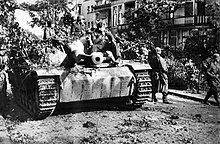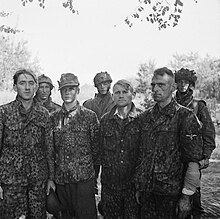9th SS Panzer Division Hohenstaufen
[7] Arriving in late March 1944,[5] the divisions were formed into the II SS Panzer Corps and were sent into the attack near the town of Tarnopol.[9] After heavy fighting in the season of rasputitsa ("roadlessness"), the division effected a link-up with Hube's forces near the town of Buchach.The II SS Panzer Corps was instead put into the line to support the weakened forces defending Caen, where Hohenstaufen suffered 1,891 casualties.It fought several rearguard actions during the retreat through France and Belgium and in early September 1944, the exhausted formation was pulled out of the line for rest and refit near the Dutch city of Arnhem.Upon arriving in the Arnhem area, the majority of the remaining armoured vehicles were loaded onto trains in preparation for transport to repair depots in Germany.[16] The Reconnaissance Battalion, a 40-vehicle unit commanded by Hauptsturmführer Viktor Eberhard Gräbner, was sent south over the bridge to scout the area around Nijmegen.[17] Meanwhile, Colonel John Frost's 2nd Battalion of the British 1st Airborne Division had advanced into Arnhem and prepared defensive positions at the northern end of the bridge.[18] An examination of the aerial photograph taken after the battle appears to show around double the dozen destroyed reconnaissance vehicles, which is the more commonly accepted number.It was to act as a reserve for Sepp Dietrich's 6th SS Panzer Army, a part of the Ardennes offensive (Unternehmen: Wacht am Rhein).At the end of February, the division was sent east to Hungary as a part of the reformed 6th SS Panzer Army under Sepp Dietrich.[5] The division, along with the majority of the SS Panzer units available, was to take part in Operation Spring Awakening, the offensive near Lake Balaton, which was aimed at relieving the forces encircled in Budapest by the Red Army.[5] Structure of the division: Heinz Hagendorf, a medical NCO, was prosecuted at the Dachau trials for firing shots at American soldiers from an ambulance marked with a Red Cross emblem in Belgium on 15 January 1945.However, in light of the controversy surrounding the Malmedy massacre trial, and that Markus Lienhart appeared to have shot two of the airmen entirely of his own volition, Schweitzer's sentence was commuted to life in prison.

Nazi GermanyWaffen-SSPanzerArmoured warfareDivisionBattle of TarnopolFalaise pocketOperation Market GardenBattle of the BulgeOperation Spring AwakeningWilhelm BittrichSylvester StadlerGermanWorld War IIEasternWestern FrontsSS Division LeibstandarteKamenets-Podolsky pocketNormandy battlesArdennes Offensive10th SS Division FrundsbergReich Labour ServicePanzergrenadierHohenstaufenHans-Valentin Hube1st Panzer ArmyUkraineErich von MansteinII SS Panzer CorpsTarnopolrasputitsaBuchachArmy Group North UkraineNormandyfighter bombers102nd SS Heavy Panzer BattalionPanther tanks277th Infantry DivisionOperation GoodwoodOperation JupiterChurchill tanksOperation TotalizeBattle of NormandyWalter HarzerArnhemSturmgeschütz IIIOperation Market-GardenBattle of Arnhem1st Airborne DivisionOosterbeekhalf trackedJohn Frost BridgeRed DevilsViktor Eberhard GräbnerNijmegenJohn FrostA Bridge Too FarPaderbornSepp Dietrich6th SS Panzer ArmyArdennesSt. VithVielsalm82nd Airborne DivisionBastogneHungaryLake BalatonBudapestThomas MüllerFriedrich-Wilhelm BockBerlin-LichterfeldeDachau trialsRed CrossBelgiumStraßgangAustriaSalzburgMalmedy massacre trialList of Waffen-SS unitsSS Panzer Division order of battleFreiburg im BreisgauWehrmacht1 Leibstandarte SS Adolf Hitler2 Das Reich3 Totenkopf5 Wiking10 Frundsberg12 Hitlerjugend11 Nordland16 Reichsführer-SS17 Götz von Berlichingen18 Horst Wessel23 Nederland6 Nord7 Prinz Eugen13 Handschar (1 Croatian)21 Skanderbeg (1 Albanian)23 Kama (2 Croatian)24 Karstjäger8 Florian Geyer33 (3 Hungarian)37 Lützow14 (1 Galician)15 (1 Latvian)19 (2 Latvian)20 (1 Estonian)25 Hunyadi (1 Hungarian)26 (2 Hungarian)27 Langemarck (1 Flemish)28 Wallonien29 RONA (1 Russian)29 (1 Italian)30 (2 Russian)30 (1 Belarusian)32 30 Januar33 Charlemagne (1 French)34 Landstorm Nederland38 "Nibelungen"4 (Panzergrenadier)35 (Grenadier)Divisional commandersDivisionsPanzer divisionsClausewitzFeldherrnhalle 1Feldherrnhalle 2